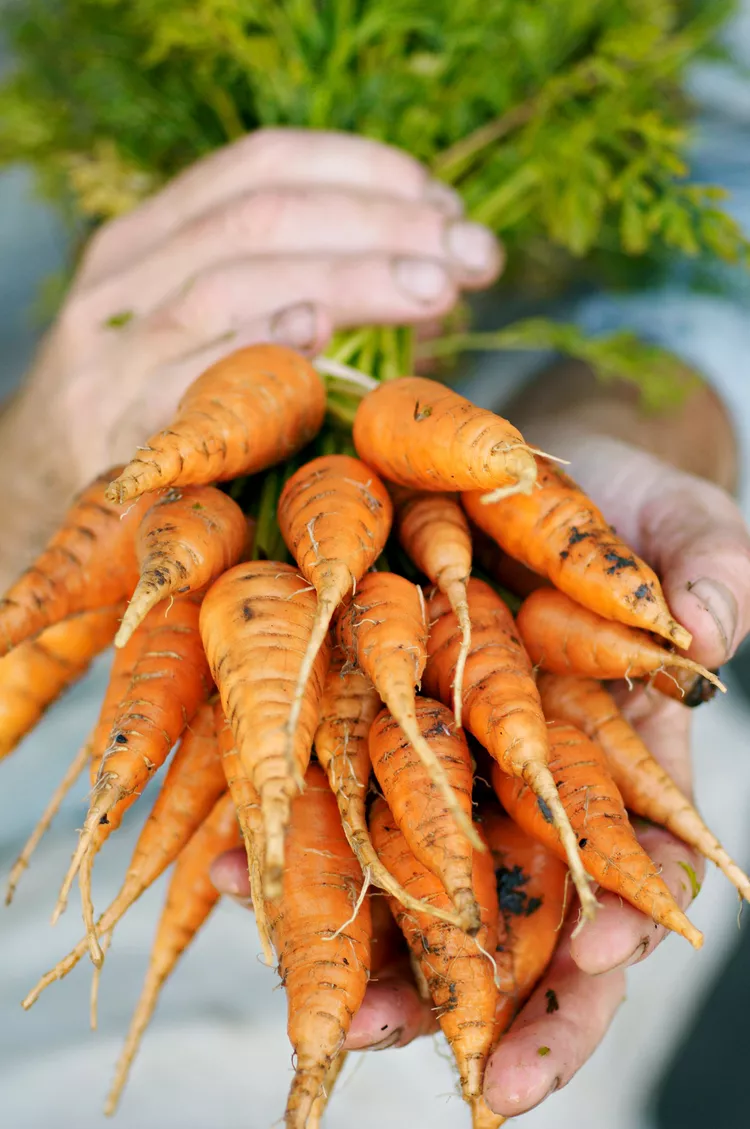Purple, white, yellow, or orange, sugary sweet carrots are always a garden treat. They’re also one of the best crops to use as companion plants. Since carrots are compact and grow low to the ground, they’re easy to slip in between larger vegetables, and their fast growth rate makes them ideal for succession planting. Try pairing these carrot companion plants to fit more crops in your garden and naturally repel a few pests.
Alliums
Alliums (onions, garlic, leeks, shallots, and scallions) and carrots love sun and rich, moist, well-draining soil. That’s not the only reason these plants make excellent companions, though. Garlic, onions, and other alliums emit a strong, sulfur-like fragrance that repels a wide variety of common carrot pests, including carrot flies. In turn, carrots attract ladybugs and other beneficial insects that feed on onion pests.
Radishes
Carrot seeds often struggle to sprout when the soil dries out and develops a tough crust across the surface. However, when fast-growing radishes are interplanted with carrots, the radishes germinate earlier and loosen the soil, so it’s easier for carrots to grow. On top of that, carrots and radishes thrive in cool weather, and they can be succession planted with each other in spring and autumn when other vegetable crops aren’t as productive.
Legumes
Beans, peas, peanuts, and other legume plants fix nitrogen in the soil, improving the growth of surrounding crops and making carrot roots and leaves grow bigger. Legume seeds can be inoculated with rhizobia bacteria before planting to enhance nitrogen fixation even further. Both bush beans and pole beans can be grown near carrots, but pole beans need trellising to keep sprawling vines from competing with carrots for light.
Beets
Carrots and beets have similar growing needs, and their cold hardy nature makes them perfect for growing in chilly spring and fall gardens. These plants can be prepared and eaten straight out of the garden, but they’re also top choices for root cellars if you want to store homegrown beets and carrots through the winter. These root veggies are vulnerable to rodent damage, so you may want to grow them in containers or grow bags if voles are active in your garden.
Tomatoes
Thanks to their compact size, carrots can be planted around the base of taller tomato plants to fill in empty garden space and boost productivity. Taller tomato plants offer light shade to heat-sensitive carrots, extending their growth a bit longer into summer. When the carrots are harvested, they return the favor by breaking up tough soil and leaving behind air pockets that make it easier for tomato roots to grow.
Heavy-feeding tomatoes can sometimes stunt carrot growth by drawing nutrients away from developing carrot roots. To avoid this issue, fertilize tomatoes regularly with a balanced fertilizer.
Rosemary
Although its strong scent repels a wide variety of garden pests, rosemary is especially good at deterring carrot flies. If you’ve ever pulled up a carrot and found the root covered with unsightly carrot fly holes and tunnels, companion planting with rosemary may be in order. Since rosemary is not cold hardy, growers in chilly climates often keep rosemary in pots in their garden beds and move potted rosemary indoors in winter.
Lettuce
Lettuce and carrots handle chilly temperatures like champs, which is why they’re often planted together in spring and autumn. Because these two plants are both light feeders and have different growth habits, they don’t compete for sunlight or nutrients, although they need rich and evenly moist soil to look their best. When grown near carrots, leafy lettuce plants act as a living mulch, sheltering the soil and making it more difficult for weeds to creep in.
Cilantro
Cilantro is another plant that does best in cool weather, so it’s no surprise that it’s a fantastic companion for cold hardy carrots. When cilantro plants are allowed to bolt, they draw in predatory insects with their tiny white flowers, helping to keep gardens and nearby carrots pest-free. To extend your harvest, succession sow fast-growing cilantro and carrot seeds every few weeks in spring and fall, but avoid planting these heat-sensitive crops during the peak of summer.
Marigolds
When it comes to pest-repelling companion plants, marigolds are at the top of many lists. French marigolds, in particular, release a substance from their roots that kills destructive nematodes. They also act as trap crops by luring thrips and slugs away from carrots and other vulnerable vegetables. Not to mention, marigolds’ sunny yellow, orange, and red flowers bring cheerful color to drab garden beds.
Oregano
Oregano offers general pest protection to vegetable gardens, and it tempts aphids away from carrots and other crops. Beyond this fragrant herb’s pest-repelling abilities, oregano can also be used as a natural mulch to shelter the soil and keep weed seeds at bay. Keep in mind that oregano plants are perennials in most areas, and you may need to work around them in spring when preparing your annual vegetable beds for planting.




















